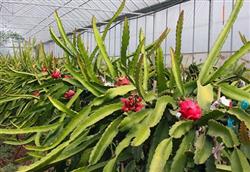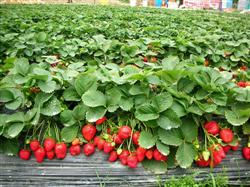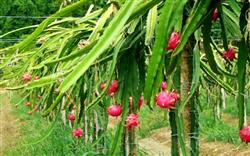Cultivation techniques of dragon fruit in solar greenhouse

Dragon Fruit, also known as Divine Dragon Fruit, is a perennial tropical plant of the genus Cactaceae, native to South America. In order to realize the south-to-north planting, the fruit was introduced in Langfang City, Hebei Province in 2002. through experiments, the first batch of fresh fruits were successfully produced after overcoming the influence of adverse climatic conditions such as high temperature and drought in the early stage and cloudy and rainy in the later stage. In order to further popularize planting, the product characteristics and cultivation techniques are introduced as follows. 1. The fruit of dragon fruit is oval in shape, covered with red scales, shaped like a lion's head, and its flesh is red and white. It is not only rich in vitamins B1, B2, B3, C, but also contains a lot of natural cellulose, glucose, carotene, calcium, phosphorus, iron and minerals needed by the human body. It also has the effects of detoxification, moisturizing intestines and stomach, clearing blood, lowering fire, lowering blood pressure, lowering cholesterol, preventing vascular sclerosis, constipation, anemia, stomatitis, cold and so on. Because it is a wild plant, it has strong adaptability and disease resistance, basically does not use pesticides, and is a pollution-free green berry. Its fruit can not only be eaten fresh, but also processed into a variety of fruit juices. The flowers of dragon fruit can also be used for cooking, stir-frying, soup and cold dressing. The flower and fruit period of dragon fruit is as long as 3-4 months, and its ornamental value is very high. it can not only do indoor bonsai, but also an ideal ornamental plant, but also the raw material for wine making. two。 According to the botanical characteristics, the main root of dragon fruit is not obvious, the lateral root is more developed, the transverse distribution diameter is more than 2 meters, and most of the roots are distributed in the topsoil layer of 10-20 cm. Pitaya is an epiphytic succulent plant whose leaves degenerate into needles in order to adapt to the long-term drought environment, and succulent stems replace the function of leaves. The plant is 2 meters high, the stem is triangular, dark green, much branched, 50-70 cm long and 5-6 cm thick; from May to November, the flower funnel-shaped milky white, up to 25 cm in diameter, 30 cm long, with fragrant smell The fruit is oval, 13-15 cm long, 9-12 cm wide, red, white or red pulp, fragrant, 12-15 degrees sugar, flowering in 6 batches within a year, more than 20 fruit per plant, 0.4-0.75 kg per fruit, and the high yield period can reach more than 30 years. 3. The choice of greenhouse can be planted in ordinary second-generation solar greenhouses. The back wall of the shed is 2 meters high, the ridge of the shed is 2.5 meters high, the span is generally no more than 7 meters, the length is about 50 meters, the thickness of the base of the wall is 2 meters, and the upper end is 1 meter. Dig a cold-proof ditch 50 cm deep in front of the shed to prevent aging polyethylene drip-free film as shed film, improve the utilization rate of light energy, thicken the cold-proof grass curtain or paper quilt, and set up three heating furnaces in the shed to prepare for the warming of overcast and snow in winter. 4. Requirements for environment and soil (1) temperature pitaya likes to be warm, the best growth temperature is 20-30 ℃, and the higher temperature difference between day and night is beneficial to the accumulation of nutrients. The experimental data showed that the dragon fruit plants grew slowly at 8 ℃, frost injury occurred when the temperature was lower than 4 ℃, and dormancy or semi-dormancy occurred when it was higher than 35 ℃ or less than 8 ℃. (2) the dragon fruit is light-loving but shade-tolerant. Sufficient light can make the plant strong and pregnant with buds, otherwise it can lead to overgrowth. (3) the water dragon fruit plant has strong drought tolerance, and it is best to keep the air humidity at 60%-70%. The number of watering in the field depends on different growing seasons. In general, low ground temperature and small evaporation in spring, slow plant growth, less water consumption should be less watering, spring and summer crisscross season, sufficient light, strong wind and large evaporation, more water should be irrigated at this time. In the midsummer sun is strong, the temperature is too high, the plant will appear short-term dormancy, should be less watering, while covering the sunshade net to cool down, and pay attention to drainage and flood control, avoid stagnant water in the field, avoid rotting roots. With the advent of autumn, the temperature is suitable, coupled with the large temperature difference between day and night, the plant grows fast, so it should be watered properly. It is better to water in the morning or evening in the hot weather and high temperature season. The plants should be watered frequently in the peak growing season, and the soil should not be wet or dry during the hanging period. Watering should be stopped 5 days before fruit picking to facilitate the accumulation of sugar. (4) the soil dragon fruit has strong adaptability to the soil, but the loam with loose air permeability, good drainage, strong water and moisture retention and rich organic matter is better, and the soil pH value is 6-7. Black clay and red clay should be improved with sand, rice husk, sawdust, peat and so on. The fertilizer used for dragon fruit cultivation is mainly nitrogen fertilizer in the seedling stage, and phosphorus and potassium fertilizer in the flower and fruit stage. mature livestock, poultry manure, rotten leaf soil, bean cake, peanut cake, bone meal and shell powder are all good fertilizer sources, supplemented by a small amount of chemical fertilizer. When preparing the soil for bed in the seedling field, 15002000 kg of rotten organic fertilizer and 100kg of superphosphate were applied per mu. Mix well with 4cm topsoil. After cutting, compound fertilizer was applied every 10-15 days, 5-7 kg per mu. For field cultivation, 4000 kg of organic fertilizer and 100kg of superphosphate were applied per mu. In the prosperous period of spring and autumn, nitrogen-based compound fertilizer is applied every 15 days, and the plant enters a semi-dormant state in summer. Fertilization should be suspended, the weather turns cool after autumn, the physiological activity of the plant is slow, and only thin fertilizer and water can be applied. Winter plants should stop fertilization when they are hibernating. The time of fertilization should be sunny morning or evening, and the effect of fertilization is better 2-3 days after rain. The concentration of fertilizer should be mastered and applied frequently. During the hanging period, some fertilizers rich in various trace elements should be applied to improve the quality of the fruit. 5. Planting method (1) the vegetative branch cutting asexual propagation method is often used in the industrial breeding of pitaya. It is required that the varieties are good, the branches are strong and free of diseases and insect pests, and the seeds should be treated strictly when cutting. The nursery should choose fields with fertile soil, good drainage and sunny ventilation. After planting, the seedlings should be watered for 7-10 days and compound fertilizer should be applied once for 10-15 days. When the first full fleshy stem is grown, and the plant is more than 50 cm high, you can come out of the nursery. (2) the width of the field planting border is 1.4 meters, and the gap between the two borders is 40 cm to make a ditch 20 cm deep, and the soil in the ditch is evenly scattered on the border surface, making the border surface high in the middle and low in the shoulders. (3) the planting density takes the cement column horizontal scaffolding as an example, the row spacing is 1.5-1.8 meters, the plant spacing is 1.2 meters, one column has two plants. There are 600 and 700 seedlings per mu. (4) the scaffolding is designed to bury cement columns in the middle of each row, plant two trees on the south side of each cement column, and make a space net of 1 inch iron wire at the top of the column to hang and secure the fruit branches. (5) timely planting pitaya can be planted all the year round, but it is suitable for March to May. 6. Pruning and branching in the field can sprout 15-20 days after planting, and the plant grows rapidly, with an average height of more than 2 cm a day, and many buds will be produced in the process of growth. therefore, attention should be paid to pruning, generally leaving only one trunk in the early stage, and all the other lateral branches are cut off, waiting for the main stem to reach the desired height (1.5-1.8 meters) before topping. Promote the breeding of lateral branches, that is, the future fruiting branches, the number of reserved branches is generally 10-15 per plant, with the growth of lateral branches, it is necessary to reasonably distribute the space, and cut off the overdense branches in time so as not to consume too much nutrients. The mature seedlings planted in May can blossom and hang fruit in May of the following year, which should be combined with artificial pollination, thinning flowers and fruits, leaving 3 or 5 fruits per hanging fruit branch. 7. The pest control of dragon fruit is wild type in the original area, and it has a strong ability to resist diseases and insect pests, but occasionally ants harm the growing point. Phoxim mixed with wheat bran or rice bran mixed with water can be used to irrigate the root 1000 times, or 800x trichlorfon solution to spray the root. The most fundamental method should start with improving the cultivation conditions and artificially create a clean, ventilated, adequate light, suitable temperature and humidity environment to make the plant grow healthily and improve the ability of resistance to diseases and insect pests. We should pay attention to strengthening scientific management, do not apply immature organic fertilizer, fertilize sparse rather than dense, and prevent stagnant water in the field. Commonly used fungicides are benzozinc (0.15%-0.35%), carbendazim or topazine (0.1%), and so on.
- Prev

Management Techniques of Strawberry Forcing Culture
1. Change flat ridge cultivation to high ridge cultivation. Flat ridge cultivation, field humidity, poor ventilation, serious diseases and insect pests, easy to cause fruit rot, quality and yield reduction. High ridge cultivation can overcome these weaknesses and is more suitable for protected cultivation. The specific practice of high ridge cultivation is: choose flat terrain, wind...
- Next

Cultivation techniques and field management of dragon fruit
First, the dragon fruit in the garden is more heat-resistant, water-resistant, like warm, humid, sandy soil rich in organic matter. Before seedling cultivation, according to the specification of 1.5 meters × 2 meters per mu, 110 10 × 10 × 250 cm concrete square columns were erected and 50 cm cement columns were embedded into the soil to support the climbing of dragon fruit branches.
Related
- Moge, come on! The staff of the peasant association in the producing area of cantaloupe were frightened when the crowd gathered.
- Causes and Solutions of low Fruit setting rate of Apple
- Symptoms and control measures of passion fruit virus disease
- Fruit growing lesson: how do apple orchards keep high yields?
- Can you build orchards in the mountains? What are the pros and cons?
- How to manage the coloring period of Crisson grape?
- This paper introduces the processing technology of two kinds of fig products.
- How much is a month for retired teachers in rural areas by 2020?
- How can strawberry planting increase sugar content? We should pay attention to management in many aspects.
- What are the cultivation techniques on how to improve the yield of golden fruit?

